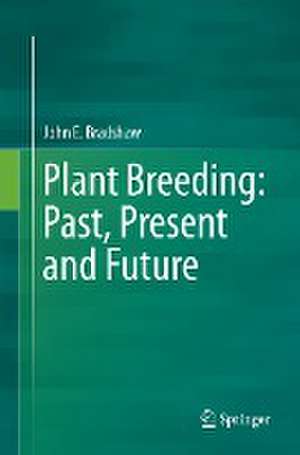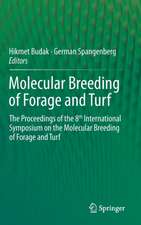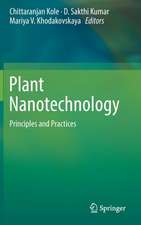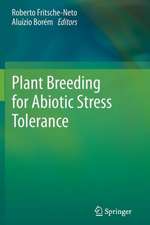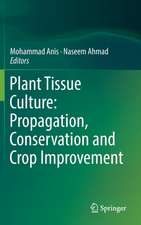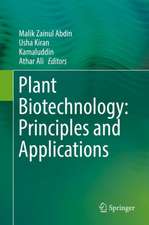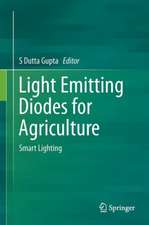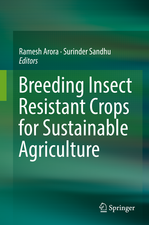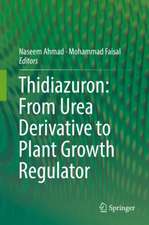Plant Breeding: Past, Present and Future
Autor John E. Bradshawen Limba Engleză Paperback – 19 apr 2018
The United Nations predicts that the global human population will continue rising to 9.0 billion by 2050. World food production will need to increase between 70-100 per cent in just 40 years. First generation bio-fuels are also using crops and cropland to produce energy rather than food. In addition, land area used for agriculture may remain static or even decrease as a result of degradation and climate change, despite more land being theoretically available, unless crops can be bred which tolerate associated abiotic stresses. Lastly, it is unlikely that steps can be taken to mitigate all of the climate change predicted to occur by 2050, and beyond, and hence adaptation of farming systems and crop production will be required to reduce predicted negative effects on yields that will occur without crop adaptation. Substantial progress will therefore be required in bridging the yield gap between what is currently achieved per unit of land and what should be possible in future, with the best farming methods and best storage and transportation of food, given the availability of suitably adapted cultivars, including adaptation to climate change. My book is divided into four parts: Part I is an historical introduction; Part II deals with the origin of genetic variation by mutation and recombination of DNA; Part III explains how the mating system of a crop species determines the genetic structure of its landraces; Part IV considers the three complementary options for future progress: use of sexual reproduction in further conventional breeding, base broadening and introgression; mutation breeding; and genetically modified crops.
| Toate formatele și edițiile | Preț | Express |
|---|---|---|
| Paperback (1) | 1236.99 lei 6-8 săpt. | |
| Springer International Publishing – 19 apr 2018 | 1236.99 lei 6-8 săpt. | |
| Hardback (1) | 1243.29 lei 6-8 săpt. | |
| Springer International Publishing – 15 mar 2016 | 1243.29 lei 6-8 săpt. |
Preț: 1236.99 lei
Preț vechi: 1508.52 lei
-18% Nou
Puncte Express: 1855
Preț estimativ în valută:
236.76€ • 246.24$ • 198.40£
236.76€ • 246.24$ • 198.40£
Carte tipărită la comandă
Livrare economică 13-27 martie
Preluare comenzi: 021 569.72.76
Specificații
ISBN-13: 9783319794648
ISBN-10: 3319794647
Ilustrații: XXVIII, 693 p. 82 illus., 56 illus. in color.
Dimensiuni: 155 x 235 mm
Greutate: 1 kg
Ediția:Softcover reprint of the original 1st ed. 2016
Editura: Springer International Publishing
Colecția Springer
Locul publicării:Cham, Switzerland
ISBN-10: 3319794647
Ilustrații: XXVIII, 693 p. 82 illus., 56 illus. in color.
Dimensiuni: 155 x 235 mm
Greutate: 1 kg
Ediția:Softcover reprint of the original 1st ed. 2016
Editura: Springer International Publishing
Colecția Springer
Locul publicării:Cham, Switzerland
Cuprins
Domestication, Dispersion, Selection and Hybridization of Cultivated Plants.- Scientific Breeding in the 20th Century and Future Goals.- DNA and the Origin of Variation.- Mendelian Genetics and Linkage Maps.- Gene Expression and Selection of Major Genes.- Quantitative Genetics and Genomic Selection.- Genotype × Environment Interactions and Selection Environments.- Genome Evolution and Polyploidy.- Genetic Structure of Landraces.- Open-Pollinated and Synthetic Cultivars from Population Improvement.- Clonal Cultivars from Multistage Multitrait Selection.- Hybrid Cultivars from Inbreeding and Crossbreeding.- Inbred Line Cultivars and Mixtures from Hybridization and Inbreeding.- Genetic Basis of Heterosis and Inbred Line versus Hybrid Cultivars.- Use of Sexual Reproduction in Base Broadening and Introgression.- Mutation Breeding.- Genetically Modified Crops.- Durable Resistance to Pests and Diseases.- Way Ahead.
Notă biografică
JohnE. Bradshaw, PhD, spent his whole professional life as plant breeder andgeneticist at the Scottish Crop Research Institute (SCRI, formerly the ScottishPlant Breeding Station and now the James Hutton Institute). He completed hiscareer as Head of Potato Breeding and Manager of the Potato Genetics Programme,funded by the Scottish Government. He has worked on barley, brassicas (kale,swedes and turnips) and potatoes; doing research on the applications ofgenetics to plant breeding methods as well as breeding two kale and three swedecultivars, and contributing to the breeding of four more swedes, a turnip, and27 potatoes. His research covered methods of kale populationimprovement, the genetic basis of heterosis in swedes, the theory and practiceof linkage and QTL analysis in tetraploid potatoes, and breeding forquantitative resistance to pests and diseases (clubroot in kale, powdery mildewin swedes, and late blight and cyst nematodes in potatoes). Dr. Bradshawis anHonorary Fellow of the Indian Potato Association and an Honorary Associate ofthe James Hutton Institute. He also holds Honorary Membership of EUCARPIA,European Association for Research on Plant Breeding (in recognition of hisoutstanding activity in the field of plant breeding science, and hisconsiderable contributions to improving international contacts in plantbreeding research). He was awarded the prestigious 2010 British Potato IndustryAward in recognition of his outstanding contribution to potato research andknowledge transfer. He has published 93 refereed papers in peer reviewedjournals, 53 other articles and 10 book chapters. He has also edited one andco-edited two books including Root and Tuber Crops (Book 7 of the Handbook ofPlant Breeding Series) with Springer.
Textul de pe ultima copertă
The United Nations predicts that the global human population will rise from the 7 billion reached in 2011 to 9 billion by 2050, and that world food production will need to increase between 70 and 100 per cent in just 40 years. Most of this increase will need to come from bridging the yield gap between what is currently achieved per unit of land and what should be possible in future, given the most appropriate farming methods and storage of food and the availability of suitably adapted cultivars, including adaptation to climate change. Breeding such cultivars is the challenge for a new generation of plant breeders who will need to decide what germplasm and which breeding methods to use, and the types of cultivar to produce. They will also need to consider new opportunities made possible by technological advances in the manipulation of DNA, the chemical basis of heredity. This book aims to help them in their endeavours by reviewing past achievements, currently successful practices andemerging methods and techniques. Theoretical considerations are presented when thought helpful. The book is divided into four parts: Part I is an historical introduction finishing with future goals; Part II deals with the origin, recognition and selection of genetic variants that affect qualitative and quantitative traits in a desired way, and concludes with genome evolution and polyploidy; Part III explains how the mating systems of crop species determine the genetic structures of their landraces and hence the types of high yielding cultivars that have been bred from them: synthetic (including open-pollinated), clonal, hybrid and inbred line (including mixtures); Part IV considers three complementary options for future progress: use of sexual reproduction in further conventional breeding, base broadening and introgression; mutation breeding; and genetically modified crops. It concludes with strategies for achieving durable resistance to pests and diseases.
Caracteristici
Set in context of increasing food production between 2015 and 2050 Extensive literature review of past successes, current practices and future possibilities in plant breeding Explanations of relevant theory Single author account of whole subject area and hence single style of presentation
